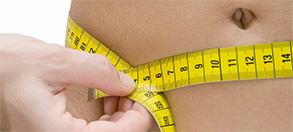
While some people are blessed with the ability to lose weight easily, many others aren’t so fortunate. For a good number of people, losing weight is a long, difficult, and frustrating journey full of yo-yos, successes, and failures.
Regardless of how one chooses to go about losing weight, counting calories always comes into play. Many people find that tracking their calories helps them lose weight more quickly because they are less likely to “cheat” if they have to write it down. It helps hold them accountable if they have to admit — even to a mobile app — that they ate that piece of chocolate cake.
Counting calories may not be your idea of a good time (and you’re certainly not alone in that), but in many respects, it’s important if you hope to lose weight and keep it off. Here’s why counting calories matters for weight loss, the best way to do it, and why losing weight isn’t just about calories.
Why Calories Matter for Weight Loss
We tend to think of calories as what’s “in” the food we eat, but a calorie is actually a measurement of energy, just as inches and centimeters are a measurements of length. Scientifically speaking, a calorie is the amount of energy needed to raise the temperature of one kilogram of water by one degree Celsius.
Of course, this doesn’t sound like it has much to do with losing weight, or food at all, for that matter. What you need to know is that our bodies need calories in order to function. Our bodies burn calories all day long — while we’re walking, digesting, breathing, and even sleeping.
We all have a basic resting metabolism — also known as the basal metabolic rate — which refers to the amount of calories you’d burn in a day if you did nothing but sit around (and unfortunately, it’s probably lower than you think it is). Getting up and moving around requires more energy, and therefore burns more calories. The more active you are, the more calories your body requires to sustain itself.
If you exercise regularly, you’d be able to eat a bit more.
The average basal metabolic rate for women is 1,400 calories (1,800 for the average man), so you would only need to eat 1,400 calories each day to sustain your body. If you work at a desk job and don’t exercise frequently, you’ll probably have to stick pretty close to this number.
Therefore, if you want to lose weight, you must burn more calories than you eat — and for most of us, that means counting them to make sure we’re not eating too much.
The Best Way to Count Calories
Thanks to hundreds (and probably thousands) of websites, mobile apps, and fitness trackers, counting your calories has never been so easy. You can log your food by choosing from a massive list of foods others have logged in the past, or enter your own custom foods (complete with nutritional value) instead.

Most food trackers will also let you choose a weight loss plan based on the amount of weight you’d like to lose per week. Based on that information, plus how many calories you’re estimated to burn each day, the website or app will recommend a number of calories to eat each day that coincides with that deficit (i.e. 250-calorie deficit to lose a half-pound per week, 500-calorie deficit to lose a full pound per week).
Fitness trackers typically come with apps that adjust your caloric allowances based on your level of activity. For example, you burn about 100 calories per mile run — depending of course, on how much you weigh (fewer calories the lighter you are) and how fast you’re running (more calories the faster you go).
Your fitness tracker would sync to the mobile app, which would calculate how many additional calories you could theoretically eat that day. So if you ran two miles, you’d be able to eat an additional 200 calories that day.
A word of warning though: fitness trackers (like treadmills and ellipticals) aren’t always accurate.
If you’re very serious about losing weight, you’ll want to err on the side of caution. Your tracker may tell you you burned 250 to 300 calories on your two-mile run, but it’s safer to stick to the 200-calorie guideline.
In addition, people oftentimes use exercise as an excuse to eat more food — you ran those two miles, so you deserve a couple cookies, right? The issue here is that many people underestimate the amount of calories in the food they eat, and overestimate the number of calories burned during exercise.
Again, it’s best to be conservative in your estimates. Exercise don’t give you free rein to eat whatever you want. Even Dwayne “The Rock” Johnson adheres to a strict diet.
How strict you should be depends on how quickly you want to lose weight and what level of discipline you can stick to long-term. Remember, the only way to lose weight and keep it off is to change your lifestyle.
Why Weight Loss Isn’t Just About Calories
When you boil weight loss down, it seems like a simple equation. You eat less than you burn, right? Well, that’s true in part.

For some people, counting calories is (mostly) all they need to do to lose weight. Keeping track of their caloric intake helps them stay on course — perhaps through eating smaller portions or reminding them that they need to move around more to burn off that bigger lunch.
But for many others, there’s a much larger aspect to weight loss: the ratio of the different types of food you’re eating. What percentage of carbs versus protein versus fat are you eating? This is often referred to as food “macros.”
Many diets have been based around various macros ratios. Atkins and keto are both extremely low-carb diet plans, but a plan like the South Beach diet is a bit more balanced — although it’s still lower carb that the typical American diet.
The Mediterranean diet is based upon the eating habits of those who live near the Mediterranean Sea. It also focuses on a balanced approach, outlining the importance of whole grains over refined sugars and breads, and specifically incorporates olives, olive oil, nuts, seeds, and fish.
The Glycemic Index plan also places an emphasis on watching carbs, but believes focusing on the right carbs can help you lose weight. Specifically, carbs that are low on the glycemic index (GI) are preferred over carbs that are high on the index.
Because this plan was designed to help people with diabetes manage their blood sugar levels, this GI number is assigned based on how great the food affects a person’s blood sugar levels.
On a scale of zero to 100, the greater the effect, the higher the number. Foods with a GI of 55 and below are considered “low” on the index, foods with a score between 56 and 69 are considered to be “medium,” and foods above 70 are considered “high.”
For example, low-fat yogurt has a GI of 14, many low-sugar vegetables (such as broccoli, carrots, celery, and cucumber) have a GI of 15, an apple has a GI of 38, a baked potato sits at 85, oatmeal comes in at 87, and a white flour bagel at 100.
The blood sugar fluctuations are exactly the reason this diet plan can help you lose weight. Foods with high GI values also trigger your body to release more insulin — a fat-storing hormone. Therefore, eating low-GI foods accomplishes two things that will help you lose weight:
- Your body can more easily access its fat stores (this is the same thought process behind the keto diet)
- Your body will store less fat.
How to Track Your Macros
The good news about tracking your macros is that the mobile or web app you choose to track your calories is very likely to break this information down for you. Each app will probably present it in a slightly different format, so you may have to spend a moment looking for it.
For example, the MyFitnessPal app spells it out relatively simply, in its own tab marked “macros,” complete with a pie chart. But the Fitbit app gives you percentages with a circular color-coded graph under its “food” tile. There are also differences if you’re using the website applications.
The most recent studies on the ideal macros for losing weight is:
- 50% carbs
- 35% protein
- 15% fat
This ratio is considered to be a good balance for keeping you satisfied and energetic, while also helping you lose fat because it allows your body to use the carbs you’ve eaten as fuel, and then move on to your fat reserves (which is the theory behind the keto diet — except that you restrict your carbs to a very small percentage, thus forcing your body to live off your fat reserves).
Additional Weight Loss Help
For some — no matter how hard they try — losing weight is still an uphill battle. After all, there are many other factors to weight loss, including health history, medications, and stress-levels. But no matter your situation, there’s always a solution.
If you’re interested in a helping hand in your weight loss journey, Houston Weight Loss is here for you. We offer weight loss counseling, vitamins and supplements to support weight loss, and appetite suppressant programs, in addition to the body sculpting procedure SmartLipo.
Schedule a consultation today at either of our convenient locations to jumpstart your weight loss!




